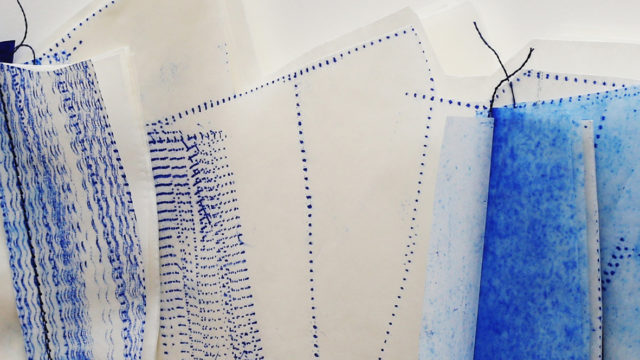
NISHAAN / TRACES
The blue of distance comes with time, with the discovery of melancholy, of loss, the texture of longing, of the complexity of the terrain we traverse, and with the years of travel. If sorrow and beauty are all tied up together, then perhaps maturity brings with it not … abstraction, but an aesthetic sense that partially redeems the losses time brings and finds beauty in the faraway.
– Rebecca Solnit, A Field Guide to Getting Lost.
In Shruti Mahajan’s Nishaan/Traces, the hues of blue appear as encounters of the past and the present, and anticipate the future. They draw from the memory of observing her father thoughtfully working through ideas on any paper at hand, developing concepts and turning electrifying blueprints into machines. Another shade seeps through memories of a contested family home and its striking character. Here it is the blue of lingering melancholy. In the dark of the night, a net holds on to a dream. These shades of blue carry the elements of personal and collective history: Indigo farms, of trade, of painstaking dyeing, even of a divinity. She posits drawings of progress in conversation with shredded fragments of prosaic entertainment. Like the colour, Mahajan’s artworks slip into various crevices, and access the depths of emotions, of agency, of storytelling and the elusive sense of self.
Mahajan employs materials and techniques to weave a web of narrative, questions power structures and the inner vulnerability of an individual by intertwining three sets of work: Chhat (roof), Ghar (home) and Dastavez(documents). Chaat is the threshold between the outside and the inside, a contained space in contrast with the limitless sky, a painstakingly mounted roof over one’s head, sometimes as humble as tarpaulin that keeps out the rain. Ghar invites you inside, and asks you to think about the depth of feeling, ideas of security and vulnerability, of childhood afternoons that evoke a haze of nostalgia. The idea of home overlaps with the idea of ownership, linking the work to Dastavez the crucial papers which prove ownership (or contest it), the documentation process of a bureaucracy, the seemingly never-ending journey of files, of administrative records, of the imposition of authority, and the privilege of having words in your favour.
Nishaan / Traces moves freely between the makers of identity, evidence of history, and its impact on the contemporary. Through materials of paper, carbon, layering with glue, stitching, folding and weaving, Mahajan annotates with ink, leaving behind smudges, as she questions the abstraction of making of maps, of ownership, of agency, and the living individual who is at the centre of all this paperwork. As remnants of past encounters, her carbon paper, like the millions still in use today, leaves its marks on the page and on fingers. Dotted lines instruct a particular folding of letters, that contained confessions, condolences, news: words may be lost, but the nostalgia remains.
Text: Aparna Andhare. Aparna Andhare is a curator at the Maharaja Sawai Man Singh II Museum, City Palace, Jaipur.